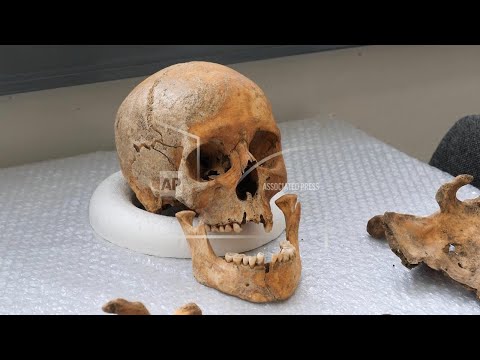(31 Jul 2025)
ASSOCIATED PRESS
Reading, Berkshire, UK – 23 July 2025
1. Close of skull of Anglo Saxon man found to have a large tumour in his sacrum
2. Zoom into skull of a woman aged about 34 who had aggressive meningioma cancer
3. Mid of skeleton
4. Close pan of teeth and jaw
5. Wide pull focus from Professor Mary Lewis to skull in foreground
6. SOUNDBITE (English) Professor Mary Lewis, Director Archaeology, University of Reading:
"When we started to wash the skull we noticed that she had a large deposit of new bone, you see this deposit of very circular new bone inside her skull and also a kind of lesion on top of her skull. So this was some kind of brain tumour and probably what we call a meningioma that would have been quite a large tumour inside her skull and probably would have come out of the skull and would have been quite a large swelling on top of her head, so it would have been very visible to people that she had something wrong. So I think this depression is where the pressure from the tumour was pushing onto the skull itself."
7. Close of inside of skull showing large dark circular depression where the brain tumour was, then Lewis turns over skull to show how it was pushing through the outer surface of the skull
8. SOUNDBITE (English) Professor Mary Lewis, Director Archaeology, University of Reading:
"It’s a time we know very little about so we refer to it as the ‘Dark Ages’. So it’s after the Romans left and before anything was really chronicled. And so it’s a very interesting period of time to look at these individuals. What’s interesting about the site is the level of pathology that we’re getting out of the individuals that have currently been excavated from the cemetery and this level of pathology is quite high given it should be a small rural community."
9. Pull focus on skeleton
10. SOUNDBITE (English) Professor Mary Lewis, Director Archaeology, University of Reading:
"We knew almost nothing about early medieval cancers, in fact it seemed to be very rare. I think of all the individuals that we’ve ever excavated from this time period we had about 0.8 percent of people had evidence of any kind of tumour. At Cookham alone from that group we had 11% of people at Cookham have tumours which is very high and it’s actually increased our knowledge of early medieval tumours from 0.8% to 1%, so it’s quite significant. It’s unlikely that individuals living in such a small area of Cookham would have all had these really aggressive cancers and they are very extreme and they would have been very visible and so our hypothesis is that these people were coming from a wider area and were coming to Cookham."
11. Close of teeth and jaw
12. SOUNDBITE (English) Professor Mary Lewis, Director Archaeology, University of Reading:
"Your teeth stop growing when you’re fully formed and then they keep the stable isotopes from your childhood. If you then as an adult move to some other location with a different geology, all of the animals and plants and the water that you’re drinking, the stable isotopes from that geology will be inserted into your bones. So if we compare the teeth with the bones we can actually see if someone moved from their childhood geology to a more recent geology."
ASSOCIATED PRESS
Cookham, Berkshire, UK – 23 July 2025
13. Various of the River Thames, a major waterway 150 metres from the excavation site
14. Tilt down of Norman church built in the 1100s
15. Deep excavation exposing a mill and lete (water channel) bringing in river water to mill grain
16. SOUNDBITE (English) Tom Hayes, head of field archaeology, University of Reading:
Find out more about AP Archive: http://www.aparchive.com/HowWeWork
Twitter: https://twitter.com/AP_Archive
Facebook: https://www.facebook.com/APArchives
Instagram: https://www.instagram.com/APNews/
You can license this story through AP Archive: http://www.aparchive.com/metadata/youtube/ee33b1948ef74843ae89fc8c4bd82e68
Author: AP Archive
Go to Source
News post in August 5, 2025, 3:06 pm.
Visit Our Sponsor’s:
News Post In – News





